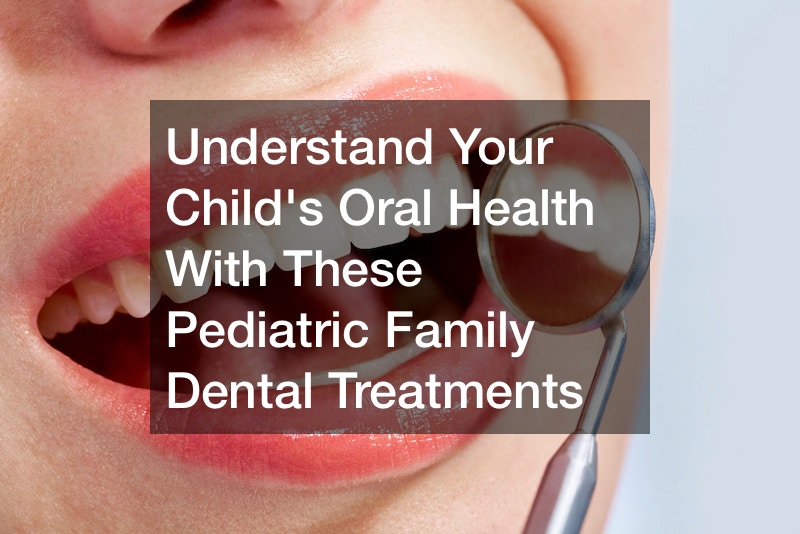
Did you know oral issues significantly impact your child’s overall health and school performance? Now you know. According to the National Institute of Health, children with dental problems are twice as likely to perform poorly at school and three times more likely to miss school. For this reason, you must prioritize pediatric family dental care and checkups to avoid disrupting your little one’s health and education.
Remember, not all heroes wear caps. Be your child’s hero by fighting oral diseases and germs. Start by understanding pediatric family dental treatments discussed exhaustively in this article. In the end, you’ll give your child a healthy smile. Let’s start!

Crowns
If your child has tooth decay, it can quickly worsen to form large cavities. According to the Centers for Disease Control and Prevention, 52% of children between six and eight years have cavities in their baby teeth. Sometimes, a tooth cavity becomes large enough to reach the nerves. When cavities are massive, the tooth loses structure and the ability to support a filling. A teeth crown is the ideal treatment option to support walls that aren’t strong enough to hold up a filling. It seals up the exposed nerve, offering a long solution, especially if you have tried pulpotomy numerous times.
A dental crown procedure is a preventive measure to avoid severe cavities and serious infections. Crowns come in different types, including stainless steel, strip, veneered steel, and white dental crowns. Typically, they are more durable than filling, lasting up to 12 years when the baby’s teeth fall off. Repairing badly decayed teeth with a dental crown helps with speech development, chewing food, and oral health and development. Crowns cover the natural tooth completely, eliminating the chance of bacteria getting in and damaging it, a win for modern-day childrens dentistry.
Implants
Your child might need a dental implant for two reasons: if they suffer from a condition affecting their teeth or lose a tooth due to misadventure or an accident. Your kids engage in risky activities at their most active age that get their teeth displaced, loose, or knocked out. Also, genetic conditions such as ectodermal dysplasia (abnormal features of sweat glands, hair, facial structure, teeth, fingers, and nails) may cause abnormalities such as defective enamel, pointed teeth, or sometimes missing teeth. Also, anodontia, another genetic defect closely related to ectodermal dysplasia, may cause a complete absence of a few or all teeth.
Dental implants offer a suitable solution for missing teeth. The tooth replacement provides a strong foundation, which improves appearance, speech, and comfort. You can eat your favorite food without pain and with confidence.
However, a dental implant is rare for young children. The primary reason is that their jawbones are in the active growth phase. So, the procedure is ideal for a teen who has completed the growth phase.
Luckily, thanks to advancements in childrens dentistry, temporary dental implants and flippers can save the day. Remember, a pediatric dental implant procedure can be complex. It’s imperative that you research and find the top local dentists with the right tools and certifications to conduct the procedure.

Braces
Premature loss of baby teeth, accidents, and tooth decay may lead to jaw or tooth problems. Also, some jaw and tooth problems are hereditary. Braces have proved an ideal solution to these teeth problems. The treatment has become an almost rite of passage in the Western world. According to the Stanford University Press Blog, 50 – 70% of children in the US wear braces before adulthood.
Orthodontists recommend braces to correct bad bites, gapping, and overcrowded, overlapping, and crooked teeth. While orthodontists are well-versed in pediatric dentistry, they specialize in correcting teeth misalignment. Let’s face it. Not all teeth grow straight. According to the Centers for Disease Control and Prevention, nearly 107 per 1000 youths undergo a teeth straightening procedure.
So, if you notice that your kid’s teeth aren’t growing straight, visit a professional for a pediatric family dental braces treatment immediately. There are various braces, including clear and colored metal braces, ceramic braces, and lingual braces, which go to the back teeth surfaces. You can choose braces made of bands with fun colors for kids.
Sleep Apnea
Does your child have sleep apnea? No problem. Consider visiting a dentist for sleep apnea solutions. Sleep apnea is a condition that disrupts your family’s sleep due to breathing interruptions. As a result, your kids may wake up tired due to poor sleep quality. The good news is that a qualified dentist will help to treat this condition.
The primary cause of sleep apnea is the blockage of your airwaves when asleep. The fatty tissues in your airwaves restrict breathing, while the tongue may fall back into your throat and block your airways. Also, improperly positioned jaws may cause the problem.
Ideally, the common treatment for sleep apnea is lifestyle changes, breathing devices, such as a continuous positive airway pressure (CPAP) machine, and oral devices. Oral devices require a visit to the dentist office. The dentist will request you to bite on a mold and send the impressions to a dental lab. The impressions help to customize an oral device that fits perfectly in your mouth.
Your customized device will mostly be ready in two weeks. For your second appointment, your dentist will demonstrate how to clean and use it properly. With this device, rest assured your family will sleep soundly.

Whitening
Has your kid lost the white sparkle on their teeth, perhaps due to developing stains or yellowish color? We can bet the idea of tooth whitening has crossed your mind. However, don’t rush to your local drugstore to grab any tooth-whitening products you see. Using the wrong products may exacerbate an already bad situation.
Before anything, visit a pediatric family dental office for safe dental care advice. Why is it important to consult a dentist, you wonder? Teeth whitening products may cause dentin demineralization and increased sensitivity. Stronger chemicals may even injure and damage the gum tissue. Whitening treatment without dentist supervision before enamel calcification, which occurs two years after developing permanent teeth, will likely destroy your child’s teeth. Overusing whitening products also causes oxidation, which destroys teeth structure.
The best solution to whiten your kid’s teeth is to follow the pediatric dentist’s advice. After the assessment, your dentist will recommend the ideal whitening products or home remedies, such as hydrogen peroxide, to eradicate the yellowish color of your child’s teeth. Additionally, consider alternative whitening solutions such as whitening toothpaste and avoid food and drinks that stain teeth.
Dental Exams
According to the New York State Department of Health, 28% of children between two and five years have already experienced tooth decay. The statistics show that children can get tooth decay, even at an early age. Consider taking your kids to see a pediatric family dental physician if you haven’t yet.
Dental exams are the best way to catch dental problems such as tooth decay, stains, and cavities at an early stage. The examinations are about preventative care; prevention is better than cure, isn’t it? The dentist will start by discussing medical history to find out if your child has allergies or if they have suffered facial injuries or trauma.
The doctor may clean their teeth if they are of age. The dentist inspects for cavities, teeth damage, misalignment, and decay during the examination. Are there missing teeth? Is the bite correct? They also check the gum tissues for inflammation, bleeding, and salivary glands. After the inspection, the dentist addresses the problems and provides oral hygiene education.
According to the National Library of Medicine, nearly 36% of the population suffers from dental anxiety. A further 12% suffer from extreme dental fear! Dental exams help kids get accustomed to dental visits, eliminating dental fear early before it develops into extreme dentophobia.

Dental Cleaning
A pediatric dental cleaning is a preventative measure that promotes excellent dental health for your child. Therefore, prioritize regular dental checkups and cleaning for your child’s overall dental health. According to the American Academy of Pediatric Dentistry, you should take your child for a pediatric family dental cleaning once every six months.
Dental cleaning helps to prevent the build-up of plaque and tartar on the hard-to-reach areas of your kid’s mouth. It minimizes the formation of bacteria, preventing tooth decay and gum diseases. A toothbrush can’t possibly clean all the parts in your kid’s mouth. Dental cleaning services come in handy, especially because children like sugary foods.
You might wonder how dental cleaning for kids works. The first step is plaque removal using manual dental tools. After getting rid of plaque and calculus, the dentist uses electronic tools to polish the teeth to make them smooth and shiny. The next step is flossing, which basically involves using a dental string to clean hard-to-reach spaces between teeth. Finally, the dentist does fluoride treatment to make the enamel strong and decay-resistant.
A dental cleaning service is cheaper than treating cavities and gum diseases and replacing missing teeth. According to Authority Dental, dental cleaning for kids costs $50 – $150. Therefore, a dental cleanup will save you significant money in the long run.
Dental Filings
Primarily, your kids will tend to fancy sugary foods and snacks. Without proper oral hygiene, the sugars feed bacteria in their mouth, producing acids. The acids will weaken the enamel quickly, facilitating cavities’ formation. It’s practically impossible to control everything your child puts into their mouth. However, the good news is that pediatric fillings are now possible for the little ones if a dental checkup identifies cavities.
A pediatric dentist will mostly recommend amalgam or composite fillings and silver for the young ones. Mainly, these two types of fillings help to protect and restore teeth. You may find it wise to consider composite fillings for either premolars or molars. They are tooth colored and will blend well with other teeth unnoticeably.
If you’re like most parents, you may think that primary teeth don’t need any attention. After all, they’ll soon fall out, right? Primary teeth positions are precisely where the secondary teeth will emerge when the time comes. Therefore, it’s critical to keep primary teeth healthy for the secondary teeth to come out healthy. So, if your child is suffering from tooth decay, visit a pediatric family dental office immediately to treat it with dental fillings and stop possible cavity development.
Dental Sealants
Even with excellent oral hygiene habits, your child can’t clean the deep grooves on the chewing surfaces of their back teeth. Additionally, germs and food can often get stuck where the bristles of their toothbrush can’t reach. Over time, this leads to the development of cavities on the chewing surface of their teeth. In such a case, the pediatric family dental remedy is to seal your child’s teeth. Primarily, sealants are thin protective coatings that a pediatric dentist paints on the molar’s chewing surfaces to prevent tooth decay.
Sealants are ideal for first and second permanent molars. As a parent, it’s essential to note that the first molars come in when your child is six years old and are commonly known as six-year molars. The second permanent molars, or twelve-year molars, will appear at age twelve. Mostly, sealants aren’t routinely applied on baby teeth. Even so, a pediatric family dental physician may recommend it if your child has intense grooves and is at a high risk of developing tooth decay.
Dental Extractions
While kids lose their primary teeth naturally, a few cases call for pediatric dental extractions. It’s normal for kids to lose their first tooth at six. Secondary teeth typically force the baby teeth out. However, if this natural process doesn’t occur, your child will probably need a dental extraction procedure to pave the way for adult teeth. Otherwise, they risk developing shark teeth. As the name suggests, your kid might develop rows of teeth like sharks. Worrying? Yes, it should be.
Kids are unpredictable. When playing, they may accidentally injure their tooth beyond repair. The pediatric dentist will recommend a dental extraction procedure if no restorative options are available. Also, an oversized cavity or bone or gum infection may necessitate the procedure. Adult teeth are permanent, and ensuring primary ones come out properly is essential to prevent future dental problems.
As a good parent, you should understand the necessary pediatric family dental procedures to keep your child’s dentition healthy. For starters, visiting a pediatric dentist is essential to check the status of your child’s dentition and maintain their overall dental health. If you need more practical tips to give your child a healthy smile, visit our website for insightful dental information.



